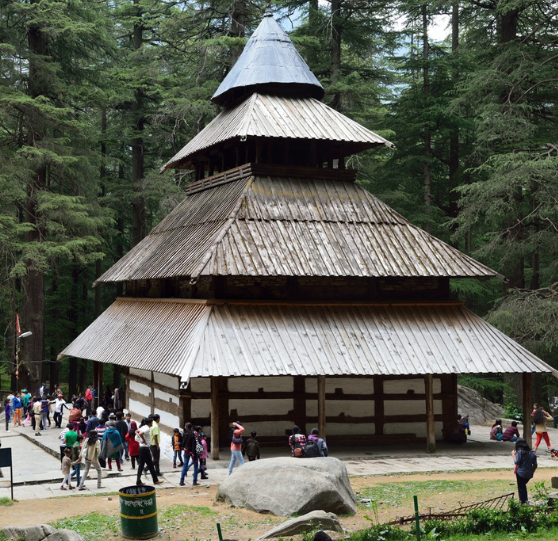
Hidimba Devi Temple, locally known as Dhungari Temple, also known variously as the Hadimba Temple, is located in Manali, a hill station in the State of Himachal Pradesh in north India. It is an ancient cave temple dedicated to Hidimbi Devi, wife of Bhima, a figure in the Indian epic Mahabhārata. The temple is surrounded by a cedar forest called Dhungiri Van Vihar at the foot of the Himalayas. The sanctuary is built over a huge rock jutting out of the ground which was worshiped as an image of the deity. The structure was built in 1553 by Maharaja Bahadur Singh. The Hidimba Devi temple is 24 meters tall.
Located in the Old Manali region, you can reach this temple through the road that passes through the Manali Community Center. Dedicated to the Indian sage Manu, this temple is the only temple on this planet that is dedicated to this sage. Thus it makes to be one of the most sacred pilgrimages for the devotees of this saint.


Manali, a spectacular hill station and attracts tourists from all around the country. It is not only popular for its mesmerizing beauty but also for the popular shopping spot– Mall Road. This place is famous for street shopping and hums with events during the day. As you wander through the streets, you can take a look at the precisely creased shops that are laden with captivating items like shawls, woolen items, artificial jewellery, woody furniture, antiques, books, Tibetan items, and whatnot. If you are looking for Kashmiri Salwar suits, paper silk printed sarees other things including jams or pickles primed in ethnic style are reasonably popular among the tourists. After your shopping splurge, you can revitalize your body by eating scrumptious treats at the restaurants on Mall Road.
Rohtang Pass is a high mountain pass (elevation 3,980 m (13,058 ft)) on the eastern end of the Pir Panjal Range of the Himalayas around 51 km (32 mi) from Manali in the Indian state of Himachal Pradesh. It connects the Kullu Valley with the Lahaul and Spiti Valleys of Himachal Pradesh, India. The pass provides a natural divide between the Kullu Valley with a primarily sanatani culture (in the south), and the arid high-altitude Lahaul and Spiti valleys with a Buddhist culture (in the north). The pass lies on the watershed between the Chenab and Beas basins.
